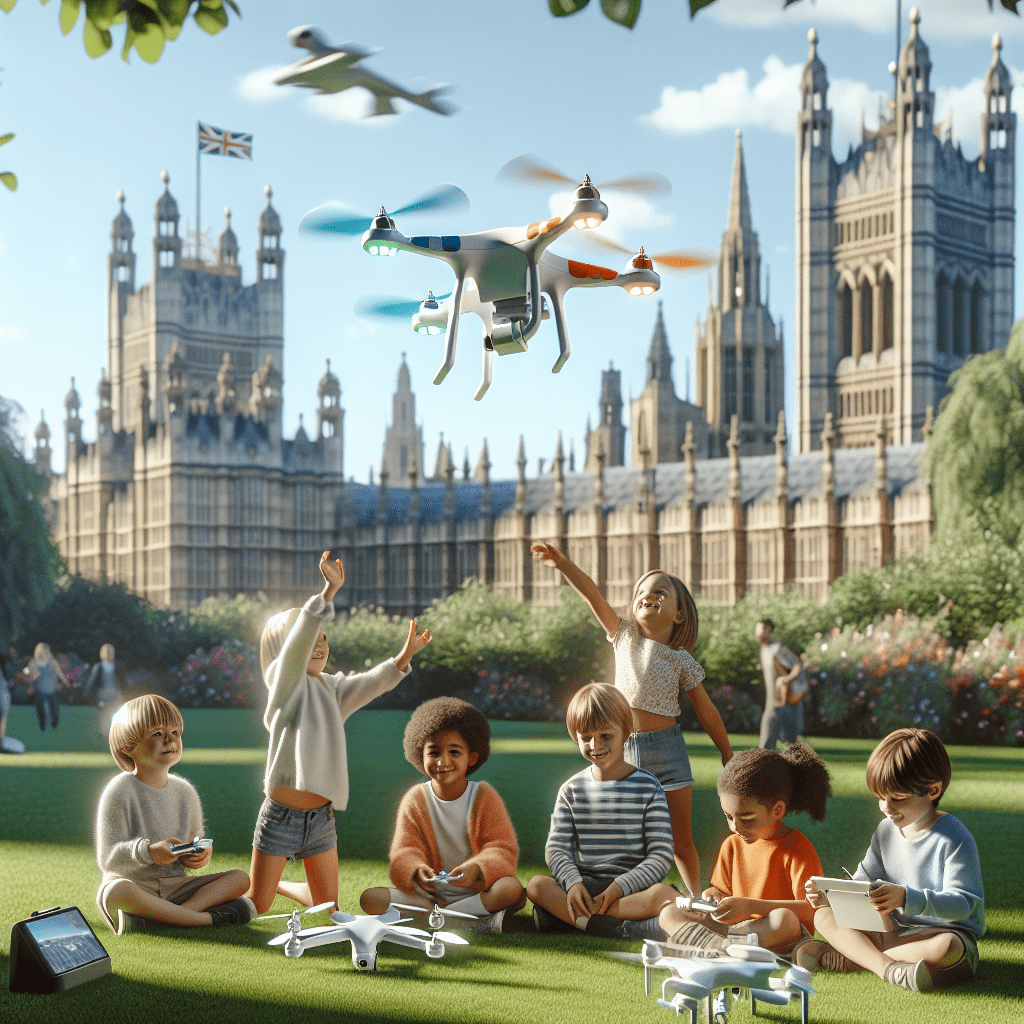Entry-Level Drones for Kids in the UK: Safe & Affordable
In This Article
- Choose Entry-Level Drones for Kids with simplified controls and safety features.
- Opt for models under 250g to avoid complex legal restrictions.
- Supervised use and education build responsible flying habits.
- Affordable options under £100 still offer high value for beginner training.
- Begin with no-camera models unless creative engagement is a goal.
Why Entry-Level Drones Are Ideal for Kids Under 12
Key Features That Make Drones Kid-Friendly
When it comes to Entry-Level Drones for Kids, there are several reasons why they’re ideal for children under 12. These drones are designed with a child’s developmental level in mind, offering simplified interfaces and crucial safety features. At this age, children are still honing their hand-eye coordination and situational awareness, which makes advanced models less suitable. Beginner drones often include protections like propeller guards and altitude hold, which collectively minimise the risk of injury or property damage.
Moreover, many kid-friendly drones feature one-touch take-off and landing buttons, which make flying less intimidating. Altitude stabilisation keeps the drone from drifting while hovering, and slow flight modes give children the opportunity to grasp basic controls without overwhelming speed. These elements ensure early drone experiences are enjoyable and nurturing, encouraging curiosity without the usual frustration that may arise from complex gadgets.
Most entry-level models also come with brightly coloured exteriors and simple controllers, making them not only safe but undeniably fun. Lightweight components are less likely to cause damage in case of crashes, and many drones for kids use softer materials to prevent breakage. Combined with parental supervision, these design traits make Entry-Level Drones for Kids a safe avenue into the world of aviation, STEM learning, and outdoor exploration.

Top 3 Entry-Level Drones for Children in the UK
Safe, Simple, and Great Value Drones
For parents scouting the market for high-quality Entry-Level Drones for Kids, these top three UK options are sure to impress. Rain or shine, these drones combine essential safety features, intuitive controls, and affordably entry points, making them ideal for young first-time pilots.
1. Holy Stone HS190 Foldable Mini Nano Drone: A compact flyer perfect for indoor and outdoor training missions. It features headless mode, altitude hold, and one-key return, ensuring accessibility for young flyers. Its compact and foldable design also allows families to take it on outings without a fuss.
2. Potensic A20 Mini Drone: Durable, vibrant, and tailored for absolute beginners, this drone includes multiple speed settings and emergency stop functions. It’s particularly suitable for younger kids due to its sturdy frame and straightforward controls, making learning a smooth process.
3. Ryze Tello by DJI (with Scratch Programming): Highly praised for educational value, this drone bridges fun and learning. It supports basic coding through MIT’s Scratch platform, encouraging kids to become pilots and programmers. Additionally, it offers surprisingly stable flights supported by DJI’s technology, making it perfect for progression.
These selections combine ease of use with valuable learning opportunities. They’re not just toys—they’re gateways to skill development, responsibility, and technical literacy. From flight basics to coding potential, each model on this list offers a strategic balance of fun and function for the aspiring young aviator.
“Our son learned to fly in less than a day with his first mini drone – the one-key control made him feel like a pro!”
Understanding UK Drone Laws for Children
If you’re considering Entry-Level Drones for Kids, it’s essential to understand current UK regulations. The Civil Aviation Authority (CAA) governs drone use and offers clear guidelines even for hobbyist flyers. Generally, all drones weighing over 250g require registration. This includes securing an Operator ID and a Flyer ID if the drone has camera-equipped capabilities.
For children under 12, the responsibility legally falls to a parent or guardian to be registered as the operator. If the drone includes a camera—even below 250g—you must adhere to laws concerning privacy and airspace encroachment. Children should be taught to avoid flying near people, roads, and built-up areas. Always fly below 400ft and maintain line-of-sight to your drone.
The CAA’s Drone Code is a vital guide for both kids and adults alike when using Entry-Level Drones for Kids. By educating young users early on about basic rule compliance, we embed values of accountability and safety from the first flight.
How to Supervise and Teach Drone Safety
Supervision is central to safe drone operation, particularly for children under 12. Start by introducing the drone indoors using limited space to reduce risk. Demonstrate first. Show how to turn the drone on and off, how to land it safely with return-to-home functions, and how to respond if the drone becomes unresponsive.
Use every session as a teaching moment. Explain potential hazards such as power lines, trees, and wildlife. Reinforce slow, intentional movements of the controller rather than impulsive actions. Don’t forget to include basic maintenance guidance, such as checking battery charge levels and inspecting blades before and after each session.
Consider setting up a family “flight zone” outdoors—preferably a safe, open field far from roads, pets, and playgrounds. This approach not only improves the child’s focus but also prevents possible distractions. Drone safety, like any skill, is best learned through patience and consistent guidance. Start simple, supervise often, and celebrate small milestones to build confidence over time.
Drone Features That Help Beginners Learn Quickly
The most effective Entry-Level Drones for Kids incorporate features specially designed for training rather than thrills. Chief among these is altitude hold, which stabilises the drone in place—eliminating the frustration of constant height corrections. Similarly, headless mode translates directional commands based on controller position, avoiding the confusion of reorientation mid-flight.
Another feature is the one-key take-off and landing function. This reduces rough landings and discourages impulsive button-mashing, while giving a child reliable control over the vehicle. Low-speed modes ensure manageable flight behaviour during initial practice sessions, and durable construction allows for inevitable bumps without tragic consequences.
Programmable LEDs or simple coding options can increase engagement for more tech-curious kids without adding overwhelming complexity. Drones that offer app-based control with basic functions tend to keep children intrigued without requiring mastery of dual joysticks. Overall, meaningful features that reduce cognitive load and increase flight stability enable children to move from cautious testers to confident pilots in record time.
How Parents Can Choose the Right Drone
Selecting the right Entry-Level Drones for Kids means finding the perfect balance between cost, capability, and safety. The first consideration should be age appropriateness. A 6-year-old might enjoy a different drone model than an 11-year-old, so match complexity with maturity. Check if the drone is labelled with a minimum recommended age and review user reviews focused on your child’s age group.
Secondly, inspect battery life. Drones that only fly for three minutes per charge can be as frustrating as exciting. Look for units offering more than eight minutes per charge and include extra batteries in your purchase if possible. Drone stability and durability should also be prioritised, especially if your child is still mastering controls.
Don’t underestimate community and support resources. Buying a model with online tutorials, active user forums, or customer service can assist you in the tricky early days. Finally, always consider whether the drone aligns with your safety thresholds, both in terms of features and UK legal requirements. Educated decisions make all the difference in extending both a drone’s life and your child’s enjoyment.
Affordable Picks: Best Drones Under £100
Affordability should not equate to compromise when shopping for Entry-Level Drones for Kids. Thankfully, several options on the market offer impressive features below the £100 price point. Brands like Holy Stone, SNAPTAIN, and Potensic routinely offer models under this bracket with stable flight, childproof controls, and reparable parts.
Mini drones typically dominate this category. Despite their size, they often include altitude hold, emergency stops, and 360° flips. For instance, the SNAPTAIN H823H Mini Drone frequently features on bestseller lists thanks to crash-resistant frames and high user satisfaction among young children and parents alike.
Shopping tip: Look for online bundles during seasonal sales which include extras such as propeller guards, multiple batteries, and portable carry cases. When in doubt, read user feedback and professional drone reviews. Learn more about Best Drones for Beginners & Children
Camera Drones vs. No-Camera Drones for Kids
Parents frequently ask whether to opt for drones with or without cameras for young users. Both offer unique advantages. Camera drones invite creativity. Children can explore aerial photography, craft videos, and even understand basic visual storytelling. Models such as Ryze Tello integrate educational apps for camera control and coding, making it a multifaceted learning instrument.
But camera drones come with extra considerations. These include additional legal implications and slightly higher price tags. You must also consider privacy and data handling implications if the drone transmits or saves footage. In contrast, no-camera drones often feature simplified electronics, lighter builds, and lower energy demands, meaning longer flight times and fewer complications for total beginners.
Ultimately, if your priority lies in STEM education, creative exploration, or early coding, a camera-enabled unit is invaluable. However, for raw flying practice and affordability, no-camera models are perfect for building confidence. Knowing your child’s interest level and monitoring responsibilities should guide your choice. Top-rated drones for kids reviewed by Digital Camera World
Best Practices for Family Drone Flights
Family drone time can be incredibly rewarding when structured effectively. Start by agreeing on safety rules and drone etiquette before take-off. Designate a pilot and co-pilot—the latter can help with spotting, issuing warnings, or assisting younger siblings. Share successes and failures to build a cooperative flying experience rather than a competitive one.
Encourage your child to become the “drone captain” for the day—managing equipment checks and helping slightly younger siblings understand key controls. Integrate practice drills: flying through hoops, smooth landings, or safe obstacle avoidance.
Use this time to teach not just flying but stewardship—responsibility for equipment, for environment, and for others. Clean up after use, recharge together, and note areas for improvement. Most importantly, make memories. Entry-Level Drones for Kids aren’t merely flying machines—they’re tools that bring generations together in fun, education, and outdoor exploration. Read a related article
Conclusion: Safe and Smart Flying for Young Pilots
[CONCLUSION_CONTENT]
Great guide on best-entry-level-drones-for-children-under-12-in-the-uk-safety-simplicity-and-price-matter-most-when-buying-drones-for-kids-browse-top-rated-child-friendly-drones-with-basic-features-and-parent – Community Feedback
What is the best drone for beginners in the UK?
The best drone for beginners in the UK combines ease of use, solid safety features, and affordability. Options like the Aero 3 Lite and DJI Mini are highly recommended for first-time flyers.
Can a 10 year old have a drone?
Yes, a 10 year old can have a drone, but a parent or guardian must register it and supervise use in line with UK safety regulations.
Can kids fly drones in the UK?
Kids under 13 in the UK need to pass an online test to obtain a Flyer ID, and a parent or guardian must help with registration and supervision during flights.
Which is the best entry level drone?
The best entry-level drone blends simple controls, durable design, and good value. Aero 3 Lite and DJI Mini 2 SE are among the top picks for children.

